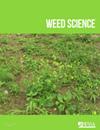覆盖作物能抑制美国东南部的杂草吗?一个荟萃分析
IF 2.1
2区 农林科学
Q2 AGRONOMY
引用次数: 0
摘要
摘要覆盖作物(CC)在美国农业种植系统中显示出抑制一年生杂草的巨大潜力。然而,CC的除草潜力可能受到特定地理区域及其相关特征的环境和管理因素的调节。在美国东南部地区尤其如此,那里较高的年平均温度和降水量为CC和杂草的生长创造了有利条件。为了了解这种区域背景对CC和杂草的影响,进行了一项荟萃分析,对东南部进行的研究中CC和裸露地面条件下的杂草生物量和/或杂草密度进行了配对比较。数据是从28篇期刊文章中确定和提取的,在这些文章中,杂草生物量和/或杂草密度与经济作物产量数据一起进行了测量(如果提供的话)。14项研究对杂草生物量进行了142次比较;23项研究对杂草密度进行了139次比较;22项研究汇集了两个杂草反应变量,对经济作物产量进行了144次比较。CC对杂草密度有负面影响(P=0.0016),但对杂草生物量(P=0.16)或经济作物产量(P=0.88)没有影响。CC下杂草密度的平均相对降低率为44%。随后的分析表明,CC生物量是与这种减少相关的关键因素。杂草密度抑制与CC生物量呈线性相关;杂草密度下降50%与6600 kg ha–1的CC生物量有关。教育、地理和其他管理因素对这种抑制作用没有影响。这突出了如果杂草抑制是CC使用的主要目标,那么产生足够的CC生物量的重要性,以及CC在不同土壤、气候和农场管理条件下降低杂草密度的潜力。本文章由计算机程序翻译,如有差异,请以英文原文为准。
Do Cover Crops Suppress Weeds in the U.S. Southeast? A Meta-Analysis
Abstract Cover crops (CCs) have shown great potential for suppressing annual weeds within agronomic cropping systems across the United States. However, the weed suppressive potential of CCs may be moderated by environmental and management factors that are specific to certain geographic areas and their associated characteristics. This may be particularly true within the U.S. Southeast, where higher mean annual temperature and precipitation generate favorable conditions for both CC and weed growth. To understand the effects of this regional context on CCs and weeds, a meta-analysis examining paired comparisons of weed biomass and/or weed density under CC and bare ground conditions from studies conducted within the Southeast was conducted. Data were identified and extracted from 28 journal articles in which weed biomass and/or weed density were measured along with cash crop yield data, if they were provided. Fourteen studies provided 142 comparisons for weed biomass; 23 studies provided 139 comparisons for weed density; and 22 studies, pooled over both weed response variables, provided 144 comparisons for cash crop yield. CCs had a negative effect on weed density (P = 0.0016) but no effect on either weed biomass (P = 0.16) or cash crop yield (P = 0.88). The mean relative reduction in weed density under CCs was 44%. Subsequent analyses indicated that CC biomass was the key factor associated with this reduction. Weed density suppression was linearly related to CC biomass; a 50% decrease in weed density was associated with 6,600 kg ha–1 of CC biomass. Edaphic, geographic, and other management factors had no bearing on this suppressive effect. This highlights the importance of generating adequate CC biomass if weed suppression is the primary objective of CC use and the potential for CCs to reduce weed density over diverse soil, climate, and farm management conditions.
求助全文
通过发布文献求助,成功后即可免费获取论文全文。
去求助
来源期刊

Weed Science
农林科学-农艺学
CiteScore
4.60
自引率
12.00%
发文量
64
审稿时长
12-24 weeks
期刊介绍:
Weed Science publishes original research and scholarship in the form of peer-reviewed articles focused on fundamental research directly related to all aspects of weed science in agricultural systems. Topics for Weed Science include:
- the biology and ecology of weeds in agricultural, forestry, aquatic, turf, recreational, rights-of-way and other settings, genetics of weeds
- herbicide resistance, chemistry, biochemistry, physiology and molecular action of herbicides and plant growth regulators used to manage undesirable vegetation
- ecology of cropping and other agricultural systems as they relate to weed management
- biological and ecological aspects of weed control tools including biological agents, and herbicide resistant crops
- effect of weed management on soil, air and water.
 求助内容:
求助内容: 应助结果提醒方式:
应助结果提醒方式:


